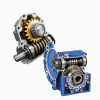| Type of Gears -
Worm Gear |
|
Video |
| A worm gear is a gear
arrangement with a cylindrical gear (worm) and a toothed wheel (worm
wheel) that transmit motion between non-intersecting, perpendicular
shafts. This design allows for very large speed reductions or torque
increases and can be self-locking, meaning the worm can drive the wheel,
but the wheel cannot turn the worm. Worm gears are used in applications
like conveyor belts, car steering systems, and musical instrument tuning
pegs, where space is limited and high reduction ratios are needed.
|
| |
| Key features and
advantages: |
- High torque in a
compact size: They can produce high torque while maintaining a
small footprint, which is ideal for applications with limited space.
- Self-locking:
Due to high friction, the gear cannot be back-driven, meaning the
output shaft will not turn the input shaft. This is a critical
safety feature for applications like hoists, lifts, and security
gates.
- High reduction
ratios: A single-stage worm gear can achieve high-speed
reductions, which would typically require multiple stages with other
gear types.
- Quiet and smooth
operation: The sliding motion between the worm and the gear
wheel results in low noise and vibration, making them suitable for
quiet environments like food processing or medical equipment.
- High shock load
resistance: They can handle significant shock loads, with some
designs rated for 300% of peak load compared to 100% for helical
bevel gears,
- Durability and
low maintenance: Worm gear systems are often durable and can
have a long service life with minimal maintenance, making them a
cost-effective choice.
|
| Disadvantages: |
- Low efficiency:
The sliding friction between the worm and the worm wheel creates
energy loss, resulting in lower efficiency compared to other gear
types.
- High heat
generation: The significant friction generates a lot of heat,
which can affect the performance and lifespan of the gears,
bearings, and lubricants.
- Increased wear:
The constant sliding contact causes wear and tear, particularly on
the worm wheel, which is often made of softer bronze.
- High maintenance
and lubrication needs: Due to wear and heat, worm gears require
frequent lubrication and maintenance to prevent damage and maintain
performance.
- Limited
reversibility: The design makes it difficult for the worm wheel
to drive the worm in the reverse direction, which can be a
disadvantage if self-locking is not the desired feature.
- Requires accurate
alignment: For optimal performance, worm gears need accurate
alignment, which can increase assembly complexity and cost.
|
| How they work |
|
A worm gear's working
principle is based on the meshing of a helical "worm" with a "worm
wheel," similar to a screw and nut. When the input worm rotates, its
threads slide against the worm wheel's teeth, turning the wheel at a
slower speed but with increased torque. The ratio of the gear's speed
reduction and torque multiplication is determined by the number of teeth
on the worm wheel and the number of "starts" (threads) on the worm.
|
| |
| Materials and
applications |
- Materials: They are
made from various materials, including plastic (like acetal or
nylon) and metals (like aluminum, brass, and stainless steel)
- Applications: They are
widely used in industries such as automotive, manufacturing, and
consumer electronics.
Plastic gears: These are lightweight, non-rusting, and can
operate without lubrication, making them suitable for food
production and medical equipment.
- Metal gears: These
offer greater strength, load-carrying capacity, and heat
resistance.
|
|
|



